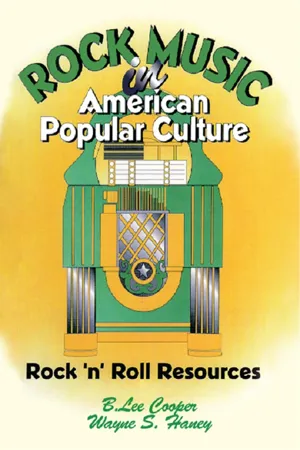![]()
Chapter 1
Baseball Songs
Social studies teachers have been encouraged to use baseball materials1 and popular song lyrics2 to stimulate students to investigate contemporary America culture. Heeding the directive of cultural historian Jacques Barzun, a few classroom instructors have tested the hypothesis that whoever wishes to discover the heart and mind of America must learn baseball. But how can baseball be translated into historical personalities, social and economic issues, humor, and other cultur/dimensions? Utilizing popular recordings that feature baseball imagery is an innovative way to introduce students to the pluralistic nature of American life. The following chapter outlines a variety of themes that combine baseball history and sporting metaphors with the lyrical poetry and rocking rhythms of popular recordings.
BASEBALL POPULARITY IN THE U.S.
Baseball is America's national game. It is also the sports repository of many of the nation's ideals, legends, and social conflicts.3 Daily and weekly newspapers chronicle the exploits of majorleague players from spring training through the World Series, with vivid game descriptions, statistical box scores, and serious journalistic analyses. Fans listen to regional radio broadcasts, watch nationally televised games, and attend ballgames to cheer their summer heroes. From Babe Ruth, Walter Johnson, and Ty Cobb to Willie Mays, Mickey Mantle, and Stan Musial, the early twentieth century focused on famous baseball players as larger—than—life figures4 Even in 1988, the spectacular pitching feats of Orel Hersheiser and the clutch—hitting theatrics of Kirk Gibson set new standards for national admiration.
Although baseball is a sport to be played, observed, analyzed, and loved by individuals, it is also a subject of mass—media interest.5 Several weekly and monthly magazines focus on player achievements and team performance—some examples are The Sporting News, Baseball Digest, and Sports Illustrated. The motion picture industry has also endeavored to capture the vitality of both major—and minor—league play. In earlier times, films like Pride of the Yankees (1942), It Happens Every Spring (1949), and Fear Strikes Out (1957) embodied the nation's fascination with baseball heroes. More recently, multiplex theaters have featured The Natural(1984), Bull Durham (1988), Eight Men Out (1988), and Field of Dreams (1989). Media attention on particular individuals or toward any sporting activity inevitably feeds public interest. Sometimes media moguls even attempt to promote popular support for a previously unrecognized athletic hero or a little—known sporting event. But acknowledging the sustained American interest in baseball, the national media usually reflects and reinforces public perceptions.
BASEBALL IMAGES IN POPULAR SONGS
American enthusiasm for baseball is undeniable. Similarly, interest in popular music is remarkably high. Some writers have asserted that the alliance between baseball and song is natural, productive, and highly popular.6 This conventional wisdom seems reasonable. Consider the lament by Simon and Garfunkel in “Mrs. Robinson” (1968): “Where have you gone, Joe DiMaggio? A nation turns its lonely eyes to you.” Or ponder John Fogerty's impassioned plea to play “Centerfield” (1985). Other contemporary songs echoing baseball themes include Bruce Springsteen's “Glory Days” (1985), Meatloaf's “Paradise by the Dashboard Light” (1978), and The Intruders’ “(Love is Like a) Baseball Game” (1968). Writers who champion the link between popular song and baseball note three primary reasons for the sport's thematic popularity: (1) baseball is celebrated as a contest of wills in a well—defined game; (2) baseball provides a showcase for national heroes and fabled athletic achievements; and (3) baseball is a useful metaphor for both dating and sex7 The aforementioned popular recordings are only the tip of the baseball—song iceberg. Although not always heard on Top 40 playlists, there are numerous audio commentaries that social studies teachers can successfully adapt for instructional purposes. For instance, the concept of death at an early age is presented in “Roberto's Gone” (1973) and “Playing Catch with the Babe” (1979). Interest in the option of examining the biographies of Roberto Clemente, Pittsburgh Pirate All—Star outfielder and international humanitarian, or Thurman Munson, Yankee catcher and flying enthusiast, can be sparked by listening to such audio eulogies Similarly, the cultural values of equality of opportunity and fair play can be clearly illustrated while discussing recordings about major—league integration during the late 1940s-“Doby at the Bat” (1948), “The Robbie—Doby Boogie” (1948), and “Doby's Boogie” (1949. Some students will be amazed to discover that Cleveland's Larry Doby was as heroic as Brooklyn's Jackie Robinson in his role as the American League's first black player. Finally, the negative reactions of fans—to shifts in baseball franchises from the East Coast to the West Coast, to extended losing streaks by local ball clubs, to player strikes, and to greedy baseball owners—are also featured on records.
TEACHING WITH BASEBALL THEMES
Classroom teachers should recognize that there are a variety of persistent lyrical themes that link baseball and American culture. Analyzing these themes can help students to conceptualize social change, cultural values, and heroic individual achievements. The remainder of this chapter outlines nine specific baseball themes depicted in songs. Featured under each theme are numerous recordings designed to stimulate discussions and debates. This information serves to illustrate baseball perspectives on twentieth-century American society through commercial recordings that feature baseball heroes, historical references, social themes, and baseball metaphors. Each theme is preceded by a brief introductory statement discussing relationships between lyrical baseball content and the broader concems of cultural context
Racial Integration of Major League Baseball Teams8
Between 1947 and 1959, major—league baseball was enriched by the contributions of b...
